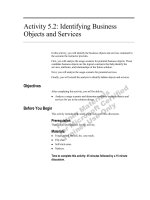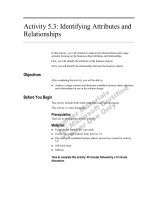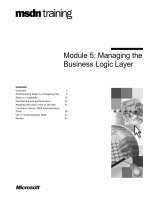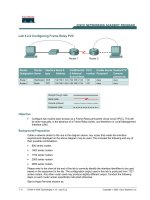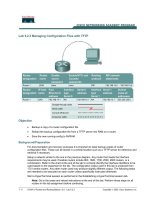Tài liệu Activity 5.2: Identifying Business Objects and Services ppt
Bạn đang xem bản rút gọn của tài liệu. Xem và tải ngay bản đầy đủ của tài liệu tại đây (86.8 KB, 4 trang )
Activity 5.2: Identifying Business
Objects and Services
In this activity, you will identify the business objects and services contained in
the scenario the instructor provides.
First, you will analyze the usage scenario for potential business objects. These
candidate business objects are the logical constructs that help identify the
services, attributes, and relationships of the future solution.
Next, you will analyze the usage scenario for potential services.
Finally, you will extend the analysis to identify hidden objects and services.
Objectives
After completing this activity, you will be able to:
!
Analyze a usage scenario and determine candidate business objects and
services for use in the solution design
Before You Begin
This activity includes both small group tasks and class discussion.
Prerequisites
There are no prerequisites for this activity.
Materials
!
Ferguson and Bardell, Inc. case study.
!
Flip chart.
!
Self-stick notes.
!
Markers.
Time to complete this activity: 45 minutes followed by a 15 minute
discussion.
30 Activity 5.2: Identifying Business Objects and Services
Exercise 1: Identifying Business Objects (15 min)
!
Identify candidate business objects in a scenario
1. Participate in small groups as assigned by the instructor.
2. Review the future-state usage scenario provided by the instructor.
3. Analyze the usage scenario for people and things (nouns).
4. Write each noun on a separate self-stick note.
5. Place the self-stick notes on a flip chart so that the team can see the results
of the analysis. These self-stick notes represent the candidate business
objects.
6. Review candidate business objects for possible redundancy or lack of
applicability.
Activity 5.2: Identifying Business Objects and Services 31
Exercise 2: Identifying Services (15 min)
After you have identified candidate business objects, you will then need to
determine the candidate services that will be provided by those business
objects.
!
Identify candidate services
1. Participate in small groups as assigned by the instructor.
2. Review the future-state usage scenario and your preliminary object model.
3. Analyze the usage scenario for the actions (verbs) that will constitute
candidate services.
4. Write each candidate service on a self-stick note.
5. Attach the self-stick note with the service to the object to which it applies.
If a service does not appear to apply to any business object, place it off to
the side for further analysis.
32 Activity 5.2: Identifying Business Objects and Services
Exercise 3: Extending the Analysis and Design (15 min)
Since a solution is made up of more then just one usage scenario, it is necessary
to expand the analysis and design by extrapolating from the candidate business
objects and services to find other business objects and services.
!
Extend the analysis and design
1. Participate in small groups as assigned by the instructor.
2. Review the future-state usage scenario.
3. Analyze the candidate objects and services that are currently listed on the
flip chart.
4. Focusing on the candidate objects, determine if there are services that can be
identified that are not currently in the usage scenario.
Write any new services on the applicable business object self-stick note.
5. Focusing on the candidate services, determine if there are objects that can be
identified that are not currently in the usage scenario.
Write any new candidate objects on a self-stick note and include on the flip
chart.
6. Iterate through these instructions as needed until the team reaches a
consensus that the key business objects and services have been identified.
After completing the above steps, you will discuss your responses with the
class. The instructor will write the class consensus on a flip chart.


